Grief’s Outline, Memory’s Shape
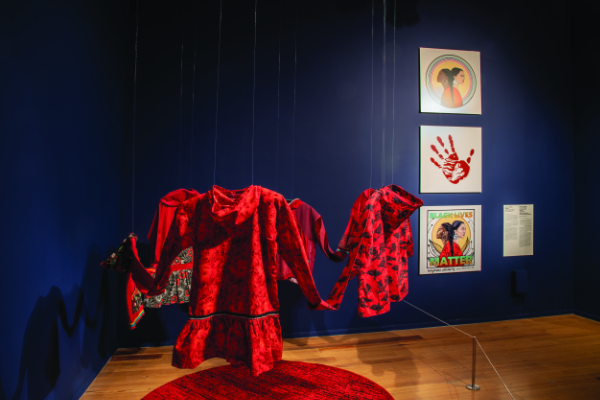 Bobby Qalutaksraq Brower (Iñupiaq, Utqiag˙vik), Melissa
Ahnoorik Ahlooruk Ingersoll (Iñupiaq, Nome), Cassandra Tikasuk Johnson
(Unalakleet), Jackie Qataliña Schaeffer (Iñupiaq, Kotzebue), Beverly Tuck
(Unangaxˆ, St. Paul Island), Healing Stitches, 2021. Cotton and polyester.
Sarah Ayaqi Whalen-Lunn (Iñupiaq), Solidarity, No More Stolen Sisters, and
Black Lives Matter, 2020. Digital illustrations on aluminum. Photograph by
Blair Clark. Courtesy of Museum of International Folk Art.
Bobby Qalutaksraq Brower (Iñupiaq, Utqiag˙vik), Melissa
Ahnoorik Ahlooruk Ingersoll (Iñupiaq, Nome), Cassandra Tikasuk Johnson
(Unalakleet), Jackie Qataliña Schaeffer (Iñupiaq, Kotzebue), Beverly Tuck
(Unangaxˆ, St. Paul Island), Healing Stitches, 2021. Cotton and polyester.
Sarah Ayaqi Whalen-Lunn (Iñupiaq), Solidarity, No More Stolen Sisters, and
Black Lives Matter, 2020. Digital illustrations on aluminum. Photograph by
Blair Clark. Courtesy of Museum of International Folk Art.
BY ANNIE WENSTRUP
Amber Webb’s Memorial Qaspeq is a permanent work in progress. Webb is a Yup’ik artist from Dillingham, Alaska, and she draws portraits of Indigenous women on an oversized qaspeq. She adds portraits to the garment as she learns the names and identities of Indigenous women who’ve been killed throughout Alaska and the Pacific Northwest. At over ten feet tall, the qaspeq’s proportions suggest the scope and scale of the Missing and Murdered Indigenous Peoples (MMIP) crisis.
While Webb’s work gestures at the enormity of the epidemic, Bobby Qalutaksraq Brower’s (Iñupiaq) project, Healing Stitches, reveals how the survivors of the MMIP crisis grieve and honor their relatives. Brower is an Iñupiaq designer who specializes in creating traditional clothing with a contemporary twist. Healing Stitches features an atikluk made by Brower, along with five other atikluks made by other artists affected by the MMIP epidemic. The project emphasizes the importance of care and connection in the face of violence.
Hanna Agasuuk Sholl’s (Sugpiaq, Alutiiq) songs, like Webb’s and Brower’s garments, reflect the artist’s desire to honor missing relatives. Sholl’s music gives voice to grief while visualizing a future founded on traditional Indigenous values. Collectively, the three artists’ work ensures loved ones are not forgotten. Viewing the qaspeq and atikluks while listening to Scholl’s music makes the loss tangible. Their work gives shape to shared grief.
In Protection: Adaptation and Resistance, a traveling exhibition from Bunnell Street Arts Center in Homer, Alaska, on view at the Museum of International Folk Art until April 7, 2024, Alaska Native artists resist erasure of culture, history, and contemporary identity. Through artwork, song, and story they document experiences and values of Alaska Native Peoples. Works by Webb, Sholl, and Brower contest the assumed invisibility of missing and murdered Indigenous Peoples.
The artists’ commemorations resist conventional assumptions about Missing and Murdered Indigenous Peoples. While the acronym MMIP evokes faceless and nameless statistics accompanied by violent imagery, the artwork in the exhibition is deeply intimate and emphasizes the individuality of the people they honor. Webb’s Memorial Qaspeq carries the faces of loved ones. In wrapping an imagined torso with relatives and friends, the garment suggests a way to move through collective grief. The qaspeq reclaims what colonization, genocide, and trauma stole from Indigenous Peoples—identities and stories of community members. By covering the imagined body with portraits, Memorial Qaspeq also reminds us that we are collectively responsible for carrying the stories and names of the relatives and friends who’ve gone missing or been murdered into the future.
Browers’ unworn garment is sized for her sister, who was murdered in 2002. What’s especially moving is how the work insists on the necessity of recognizing relatives and community members within the context of relationships.
Webb’s and Brower’s artwork invites the audience to imagine the women who should be in the room, laughing and visiting with each other, the relatives who should be wearing the atikluks—holding hands with the artists instead of with empty fabric. Sholl’s music asks the audience to substitute their physical presence for one of the artist’s family members. In “Words to My Brother,” Sholl voices the conversations she can’t have with her sibling. The audience’s ears must fill in for his presence. But the work does not accept the audience as a perfect substitute. Lacking her brother’s response, the lyrics repeat, changing in pitch and cadence without reaching resolution.
In our conversations, each of the artists reiterated that the process of creating was as important as the work itself. Sholl and Webb reminded me that it’s important that their projects reflect traditional values of respect. For Sholl, this meant workshopping some of her songs with other Indigenous songwriters. Similarly, Webb emphasized that the knowledge and stories she shares and advocates are communal. That awareness is reflected in her commitment to acknowledging how grassroots MMIP advocates have shaped her path.
Brower explained to me that the atikluks were created in a workshop she led. All the participants were Indigenous women whose lives are affected by the MMIP crisis. Brower is proud the workshop became a safe space where participants could grieve with others who understood. Describing the workshop and exhibition, Brower says, “We are the circle of protection. We can take care of each other, even if it’s just through prayer. It helps.”
The Missing and Murdered Indigenous Peoples Crisis:
An Epidemic Rooted in the Interstices of Colonialism and Racism
The phrase most frequently used to refer to Indigenous Peoples who were murdered or who are missing because of racialized and gendered violence is Missing and Murdered Indigenous Women. Recently, activists have advocated for updating that phrase. As Webb reminded me, transgender, nonbinary, and Two-Spirit Indigenous Peoples also experience racialized and gendered violence. Brower pointed out that Indigenous men are also at increased risk of being murdered or listed as missing because of racialized violence. Both artists also noted that the Missing and Murdered Indigenous Peoples crisis is connected to rates of domestic violence and substance use disorder.
Webb notes, “[people say] we somehow cause the violence that happens to us, but the [violence] is really a part of colonization.” In the same vein, exhibition curator Asia Freeman remarked, “Indigenous communities are not responsible for historic trauma, but they still must survive and live through it.”
Freeman, a non-Indigenous ally and artistic director at Bunnell Street Arts Center, is acutely aware of how structural racism continues to enact violence on Indigenous Peoples throughout Alaska. She believes that true cross-cultural support and the elevation of Indigenous Peoples’ voices is impossible without first reckoning with the effects of colonialism and genocide. “These lives, these missing and murdered people, the families who have been impacted—their voices have not been elevated through the funding and solving of cases,” Freeman says. “It’s as if their lives are viewed as less important.”
In Alaska, that system of inequity is reflected in the state’s higher-than-average percentage of Indigenous Peoples who are missing or have been murdered. According to a 2018 study by the Urban Health Institute (UHI), Alaska ranks fourth in the nation in the number of cases reporting Indigenous women who’ve been murdered or are listed as missing. Because of structural problems in how the judicial system handles cases involving Indigenous Peoples, the UHI report is limited in what it can tell us about the crisis’s scope. Additionally, although the UHI report is one of the most comprehensive examinations of its kind, it specifically looks at cases in urban areas and against women. As a result, the report cannot speak to violence in rural areas or violence committed against men, nonbinary, and Two-Spirit people.
The lack of definitive data on the MMIP crisis is recognized by multiple agencies, including The Bureau of Indian Affairs. The BIA notes that nationwide data on MMIP is incomplete and inaccurate, stating that “there is no reliable count of how many Native women go missing or are killed each year. … thousands have been left off a federal missing-persons [databases].” The UHI report identifies the problem as three-part institutional erasure, “in life, in the media, and then in the data.”
The missing data is a state and federal problem. The federal government maintains a national database, the National Missing and Unidentified Persons System (NamUs). The database is not limited to Indigenous Peoples, rather it compiles information about anyone listed as missing or unidentified throughout the U.S. However, states aren’t required to update the NamUS. Presently, the largest database of MMIP-specific data is maintained by Sovereign Bodies Institute, a non-government, Indigenous-led organization.
The lack of data is a symptom of the judicial system’s perpetuation of inequality. If the violent acts against Indigenous Peoples remain undocumented (the way genocide, pandemics, and the deaths of Indigenous children at boarding schools were undocumented) it’s impossible to define the scope of the crisis. Without being able to define the problem, it is difficult to address the root causes or to hold perpetrators accountable. For the survivors, or people killed or missing due to racialized violence, how can they advocate through a justice system that does not value them?
MMIP and New Mexico
The Protection: Adaptation and Resistance exhibition’s presence in New Mexico is timely. The same 2018 UHI study that ranked Alaska fourth in the nation for Missing and Murdered Indigenous Peoples ranks New Mexico first. The report’s findings prompted New Mexico state lawmakers to create a task force in 2019 to address the epidemic. One of its first goals was to increase the quality and quantity of MMIP data. The task force requested that law enforcement organizations throughout the state provide demographic data about individuals listed as murdered or missing. However, in a 2020 report, the task force reported that law enforcement agencies deemed the request “excessively burdensome or broad,” limiting the task force’s ability to improve the state’s data.
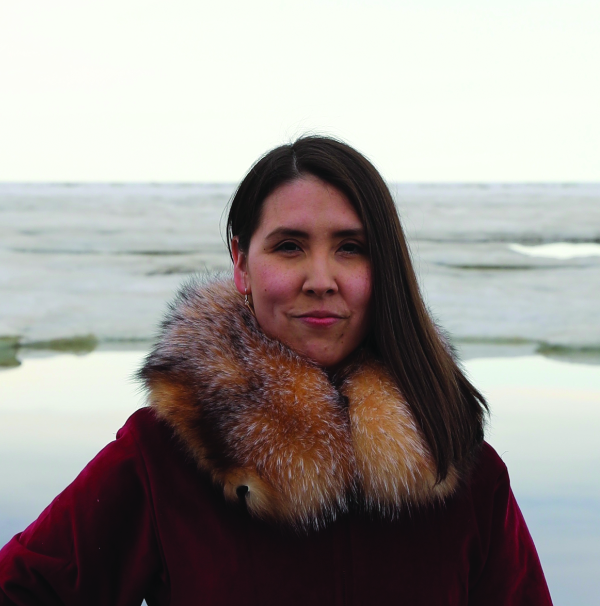
Despite facing resistance from law enforcement, the task force continued to advocate for people affected by the MMIP crisis until the summer of 2023 when Governor Michelle Lujan Grisham’s administration disbanded it. In November 2023, Lujan Grisham’s administration announced the creation of an advisory council. Because the council’s role and scope appeared to be limited, former task force members worried there would be no community input or budget to ensure real changes on the ground. As a result, task force supporters introduced Senate Joint Memorial 2 during this year’s legislative session which requests the creation of a permanent forty-member task force housed in the New Mexico attorney general’s office. At the time of publication, the Memorial had been passed and awaited action by the attorney general.
As I wait to learn what will become of the task force and advisory council, I keep thinking about an anecdote Brower shared:
A few years ago, when I went to my first Indian Market in New Mexico, some guy came up to my booth and asked if the whole epidemic of Missing and Murdered Indigenous Women was a real thing. That blew my mind. I [told him] “I’ve been directly affected. My sister was missing and murdered. So yeah, it’s a real thing. It’s not made up. Why would we make something like that up?” It made me really sad.
Holding Hands, That’s How We Protect Each Other:
Bobby Qalutaksraq Brower’s Reminder that No One is Anonymous
Healing Stitches began as an online workshop Brower offered during the pandemic. Four participants, Melissa Ahnoorik Ahlooruk Ingersoll, Cassandra Tikasuk Johnson, Jackie Qataliña Schaeffer, and Beverly Tuck, plus Brower, honored Indigenous relatives who’d been murdered or are missing, by sewing atikluks.
Atikluk is the Iñupiaq name for a hooded and pocketed overshirt with trim on the cuffs and sleeves. The garment appears across Alaska Native cultures with its form and name varying depending on the community and families that create it. In Central Alaskan Yugtun it’s known as a qaspeq or kuspuk, in St. Lawrence Island Yugtun it’s called a qiipaghaq, while in Koyukon Athabascan it’s called me’tsegh’ hoolaanh. The garment is not regalia. Instead, it’s everyday clothing that serves as a reminder of Indigenous presence in Alaska.
Brower is an Iñupiaq fashion artist and furrier. She’s the owner of Arctic Luxe where she sells and promotes Indigenous clothing and accessories. Brower didn’t set out to be an advocate for Indigenous Peoples who’d been murdered or are missing. Instead, her advocacy work grew out of a project in memory of her sister, Nancy. In 2018, the Bunnell Street Arts Center asked Brower to participate in their 2019 Qaspeq/Kuspuk/Atikluk Invitational Exhibit. “I had a red lace atikluk that I made in honor of my sister who was murdered twenty years ago,” Brower says. “It was the first time I kind of advocated for Missing and Murdered Indigenous Women. It’s a difficult topic to even talk about or advocate for.”
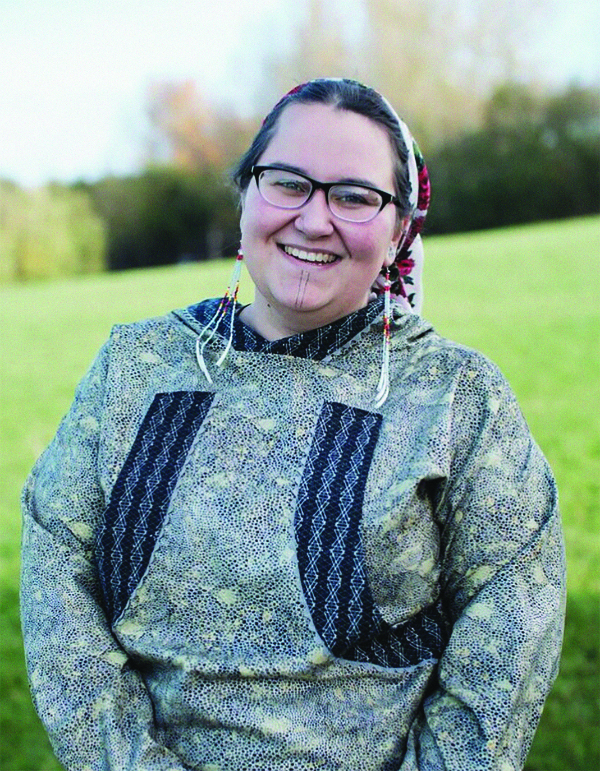
After the exhibition closed, Asia Freeman, curator of Protection: Adaptation and Resistance, asked Brower if she’d participate in an exhibition that addressed the Missing and Murdered Indigenous Peoples crisis. Brower proposed a workshop as a safe place for people who’d experienced the violent loss of a loved one to receive support while creating an atikluk.
Five atikluks hang at adult-shoulder height, one child-sized atikluk closer to the ground. It’s as though they’re waiting for the missing women and child to step into and animate them again. If they were being worn, the six wearers would be facing each other. Brower connected each atikluk cuff to its neighbor’s—as though they are holding hands. Each garment is red in a nod to the Red Dress Movement, but the fabric is varied. Some, like Brower’s, Tuck’s, and Ingersoll’s, are made from cotton quilting fabric and edged with ric rac, while Shaeffer’s is a heavier weave, edged with long red fringe. Johnson’s atikluk incorporates deconstructed winter coats, along with the quilting fabric, bias trim, and ric rac.
For Brower, the display is meant to suggest communal closeness, like a group of people close enough to pray together. For the viewer, there’s a discrepancy between the suggested kinship and the fact there is no one physically present. The eye cannot resolve the cognitive dissonance: the neat stitches, vivid fabric, and carefully matched trims attest that the intended wearer is claimed by a community grieving for them.
For Brower, the process of selecting materials helped her process things she didn’t have language for.
It has red and black ravens on it, and she used to act like a raven. So, when I see it, I think of her. The atikluk is kind of a common one, it doesn’t have a traditional skirt. It’s more of a regular shirt with long sleeves and a hood, which was more her style because she was more of a tomboy. And she would never wear dresses. So, I had to figure out what she would actually wear. And it turned out! I feel like it suits, like it really honors who she was.
When displayed, the atikluks provoke questions about grief, persistence, and presence. Brower explains that the display places her work in conversation with other Indigenous artists and activists responding to the MMIP crisis.
“The way we have everything set up was made to be kind of like the Red Dress Movement where they hang red dresses up in trees to honor Missing and Murdered Indigenous Women. That was kind of what the display was about. And also, to have a circle—the protection.” The Red Dress Project is an ongoing public art installation project by Jamie Black, a Métis and Finnish artist based in Winnipeg. Brower’s reference highlights how the MMIP crisis is not limited to a specific community or nation. Instead, the MMIP crisis exists wherever Indigenous Peoples have experienced colonialism. Similarly, Black’s project’s roots extend outside of Black’s community, finding solidarity with women in Bogotá, Colombia, where women wore red dresses to demonstrations protesting their government’s lack of action when women were killed.
Brower notes that the atikluks in the display reflect communal values of support:
They’re holding hands in the exhibit. That’s kind of how I feel we protect each other, and how we protect our families and my hometown. [Seeing them in a circle] makes people remember that they’re in a relationship. It’s not an isolated person, it’s not somebody that is unfamiliar, it’s somebody who’s part of a community who’s missing. … You know, it affects all of us. Even if we’re not directly related. I feel like we’re all from different places, but we’re all connected because we’re all Indigenous.
Brower recognizes that communal support also necessitates shared grief. “It affects all of us because if someone goes missing and they’re not even like a relative of mine, it affects how I feel about being Indigenous. It’s tough being Indigenous, but when you are in the circle of protection, it makes me think we can take care of each other even if it’s just through a prayer.”Brower hopes the workshop and the Protection exhibition further the conversation about the gendered and racialized violence. She sees an ongoing need for advocacy work. “The workshop was a way to honor somebody that went missing or was murdered. I also hope it has opened eyes to people that this is a real and serious thing,” Brower says. “There’s been quite a few people who’ve gone missing in my hometown in the past, like ten years, and they don’t know what happened to them. It’s still happening every day.”
I Am the Steward of a Story: Amber Webb
on Collective Responsibility in the Face of the MMIP Crisis
The portraits of more than two hundred women look out over the gallery space. They’re part of Webb’s Memorial Qaspeq, a series of portraits drawn in black Sharpie on a twelve-foot-high muslin qaspeq. Before sewing the Memorial Qaspeq, Webb created a smaller prototype that recognized and honored forty-seven women in Alaska affected by the MMIP crisis. As she sewed the prototype, she tried to learn more about their lives. She was frustrated by the lack of available information noting that she “couldn’t even find all their pictures.”
For the Memorial Qaspeq Webb felt it was important to include portraits of Indigenous women from outside Alaska. She recognized that some information she came across about the women existed because of advocacy groups based elsewhere.
“I thought I should acknowledge and connect to the work that’s being done all over the United States and Canada, where people are talking about this issue,” Webb says. “We know that the violence is happening anywhere Native women exist. The violence is part of colonization. So, I wanted to honor the grassroots work that’s been done in a lot of different communities.”
Webb initially imagined that she’d represent the women who are missing or been murdered by drawing feathers or a bird on the qaspeq. As she worked on the prototype, she decided to draw faces instead.
I was trying to represent our women and destigmatize them. There’s so many stories people tell about us, but they’re not historically accurate. They are not our stories, but people will tell the story that we all (Indigenous Peoples) have substance use issues or that somehow we cause the violence that happens to us, as if it’s not worth looking for these different narratives that are part of colonization. They see us as objects or treat us like cheap labor.
Webb hopes her work resists easy tropes perpetuated by news, media, and popular culture that flatten the representation of people who’ve experienced violence. “I wanted to show that it doesn’t matter where we come from, what our life choices are, or what we’re doing,” she says. “We face high rates of violence no matter what choices we make.”
Webb notes that while touring with the qaspeq, people share stories with her that underline the constant threats of violence Indigenous women experience.
As I toured … people would tell me stories about being targeted by suspicious vehicles, or about partners that would threaten them … things that were representative of a much bigger problem. So, for every woman that we know is killed, we have thousands more that are experiencing different forms of violence throughout their lifetime, and I just wanted to talk about that. I wanted to focus on the fact that these human beings—they lived. And we shouldn’t focus on the way they died or on how colonization came down on them. We should focus on who they really were.
The desire to honor the lives of Missing and Murdered Indigenous Peoples is a responsibility Webb takes seriously. “When I did this qaspeq project I read every woman’s story. I know details about their lives. I know their names. I know where they’re from. I’ll never forget those women when I see those portraits,” she says.
She is also conscientious of how she delineates her role as an artist responding and advocating for Missing and Murdered Indigenous Peoples. She says the portraits are a collection of stories that don’t belong to her.
I feel like I’m a steward of a story, a collection of stories. It’s like the concept behind the show being protection. We’re talking about upholding and uplifting things that don’t belong to us, they’re of us, we’re a part of them, but there’s a collective responsibility for that. I think the show uplifts that—the collective responsibility of being a Native person and being in community.
A Call to a Ceremony:
Hanna Agasuuq Sholl’s Music for a Radically Imagined Future
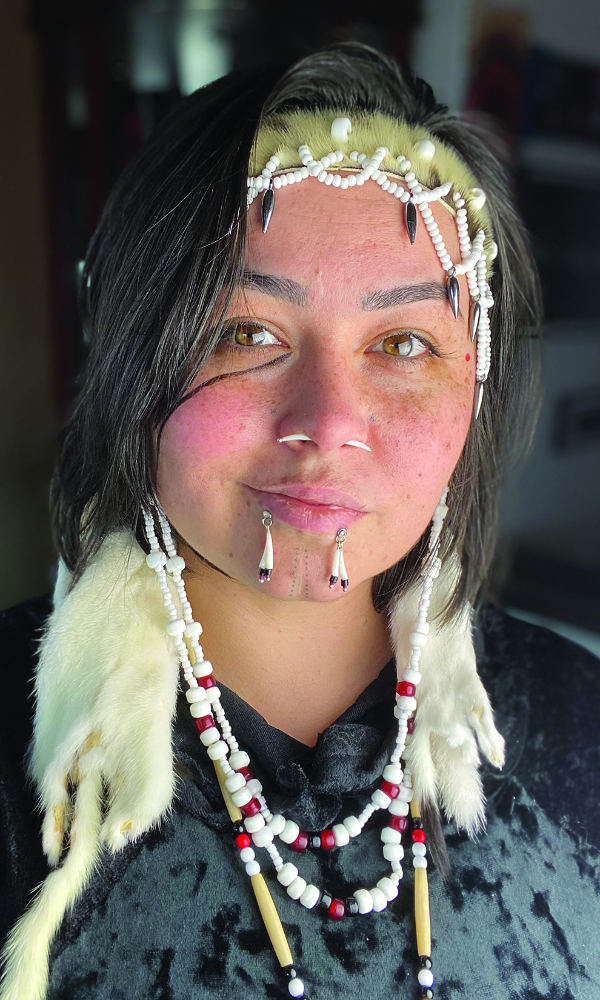
Three songs composed by Sugpiaq artist Sholl accompany the visual works in Protection: Adaptation and Resistance. Sholl hopes her music educates non-Native listeners about the issues Indigenous Peoples face such as racism, substance use, cultural appropriation, and domestic violence. She also hopes her music uplifts Native communities. “One of the most essential parts of my art is encouraging our people to use art as a form of healing, with the understanding we do not have to be another generation of trauma,” Sholl says.Sholl’s music speaks to that hope. Taken together, her songs “Words to My Brother,” “Deer Hunt,” and “Overcome,” speak to a world where Indigenous Peoples have experienced violence and loss while still remaining present for their communities and imagining their futures.
She notes that “Words to My Brother” was born from a need to tackle emotions and experiences that she didn’t have language for. Scholl says that writing the song helped her express things she wanted to say to her brother but couldn’t.
This song doesn’t have a lot of words to it. The change in the words and change in sounds really is where the expression comes out in this song. It repeats itself. It was designed to have a conversation with my brother without having to speak these words or having to process and share these emotions that are so deep and painful that I don’t even have words for them. In the repetition I’m filling them with emotion. Anyone who’s dealt with or witnessed or lost anyone, or anyone who has family who’s recovered from addiction, they know you’re left without words. There’s no way to process emotions. Even if you say the words, they don’t express what you feel.
Scholl imagines the song “Overcome” as a relative to “Words to My Brother.” She says,
This is about collectively finding our power and coming together to bring these issues forward. It’s almost as if it’s a symbolic dance that is designed to paint a picture of what it would look like if we were able to come together and really process through these issues and support each other.
For Scholl, community connection and resolution through ancestral knowledge becomes its own form of healing.
It’s a song of hope and resilience and almost like an open invitation to a ceremony that hasn’t yet been created to bring us all together and solve the world’s problems. Solve our world, solve our nation, our tribe or reservation, our regional area. Solve all those problems. The song becomes a call to a ceremony that has not been awoken yet.
On the surface, Sholl’s third song, “Deer Hunt” is stylistically different from both “Overcome” and “Words to My Brother.” The song was written to celebrate her son’s first hunt as well as to share cultural values.
It’s a very light song. It’s from the perspective of a child reclaiming their own cultural identity through hunting. The idea of sharing about a successful hunt together and celebrating, giving respect to the hunt that just took place and the animal—that ensures there would be future successful hunts.
While “Deer Hunt” is situated in the present, it reaches backwards and forwards in time. The song’s embrace of traditional form and values in the present create the possibility of future. That sense of interconnectedness is intrinsic to Sholl’s practice. She’s quick to assert her songs and their creation are part of something larger than herself.
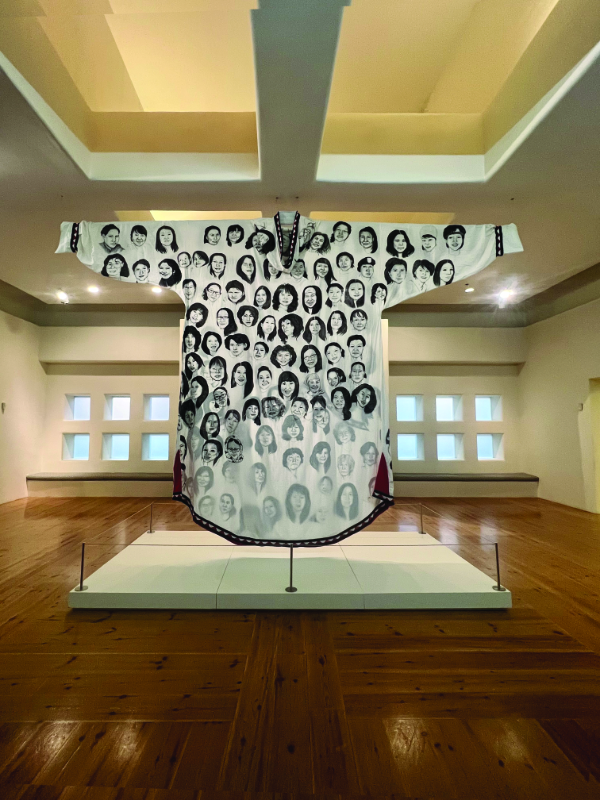
The songs about healing and processing were done in pieces and then placed together. I almost feel bad taking credit for them because it’s more like there was … I don’t want to say something working through me to create them, but essentially, that’s what it was. It’s the importance of connection. I have worked really hard to develop a very deep connection with my ancestry and the lands that I’m on and the people I work with and the people I learn about. Song development has become more of a spiritual practice and less of what we think of in Westernized society of sitting down and writing a song, recording it in a padded room, and then monetizing it.
Art as Resistance, Art as Ceremony
The structural violence that perpetuates the MMIP crisis is not limited to law enforcement or the judicial system. It’s pervasive. While writing this article it has felt impossible to respectfully refer to community members and relatives who have been murdered or who are missing. In English there are few ways to collectively name Indigenous Peoples who are missing or who’ve been murdered without using the passive voice. One option is to use individual names, but this is challenging when families wish to protect privacy. Beyond this, how can I name each affected individual? The databases are incomplete.
The active voice would insert the subject into the phrase and name the perpetrator behind the deaths and disappearances of Indigenous Peoples. Colonization, racism, natural resource extraction, and human trafficking murder and disappear Indigenous Peoples.
That’s also unsatisfactory. The failure in nomenclature speaks to a structural inability to name the sentence’s subject without objectifying Indigenous Peoples. In English it’s difficult to honor the individuality and humanity of a collective, linked because they experienced violence rooted in white supremacy and colonialism.
I think this is why I’m deeply moved when I witness Brower’s, Sholl’s, and Webb’s work. Their art succeeds where language fails me. They’ve insisted on the physicality and presence of the people they honor and remember. The atikluks, qaspeq, and songs render what’s been obscured—in data and in language—into tangible expressions encompassing grief, community, and love.
Their art extends community to the audience. For an Indigenous audience, acknowledging the horror and violence of the MMIP crisis, it’s an empowering act of truth-telling. For a non-Indigenous audience, it’s an invitation to learn about Indigenous realities. From that communal place the work becomes restorative, not only for the present audience but also for missing loved ones.
By creating work with traditional values, in relationship to other Indigenous Peoples, and respect for story—their artwork refuses to allow isolation and violence to be the last portion of their loved ones’ stories. In their art and advocacy Webb, Sholl, and Brower carry their relatives’ and communities’ stories into the future. Those stories become commemoration and a call to end violence against Indigenous Peoples.
—
Annie Wenstrup is a Dena’ina writer living in Fairbanks, Alaska. She serves as the Donor and Alumni Relationship Coordinator for Indigenous Nations Poets.
